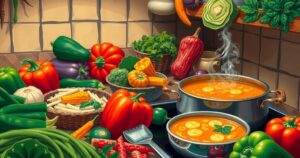Exploring the Flavors of South African Cuisine: A Culinary Melting Pot
South African cuisine is a vibrant blend of diverse flavors influenced by various cultures. Warren Mendes sheds light on this culinary landscape by discussing dishes like bobotie and bunny chow, which exemplify the fusion of traditions. Recipes showcased reflect the country’s rich history, making South Africa a true melting pot of flavors.
South African cuisine is known for its vibrant and diverse nature, blending influences from various cultures. Warren Mendes, a South African-born Australian cook, explains that the nation, termed ‘The Rainbow Nation’, has cuisine shaped by its rich history and melting pot of flavors. Alongside traditional dishes like milk tart and biltong, one can find a recipe showcase reflecting these unique culinary intersections.
In South Africa, the impact of colonization in the 17th century introduced a variety of spices and flavors from the East. This blend of culinary traditions has resulted in dishes such as bobotie, which combines British influences with Indian spices. The dish typically features spiced minced meat topped with a custard layer, a delightful example of South African flavor fusion.
The popular condiment chakalaka is a testament to this culinary diversity, originating as a Zulu recipe mingled with Indian and Cape Malay influences. It’s essential for barbecues in South Africa, enhancing simple dishes like steak and transforming them into flavorful experiences. Various communities celebrate this diversity through foods from different origins, such as the sponge cake, koesister, and diverse pastries found in bakeries.
One dish Mendes highlights is bunny chow, a hearty curry served in a hollowed loaf of bread, originating from Indian merchants in Durban. This down-to-earth comfort food demonstrates how bread serves as a base instead of rice, creating a filling meal that reflects the country’s cultural mix. Mendes’s recipe usually features chicken curry and is topped with carrot sambal for added flavor.
Another dish is Rooibos crème brûlée, representing simplicity in preparation while delivering unique South African flavors. Rooibos tea, well-known for its herbal properties, is the centerpiece of this dessert, showcasing how home cooking can highlight local ingredients. Cape Malay chicken curry is another prized dish, commonly paired with homemade roti, blending influences from various regions.
For a barbecue staple, pap, boerewors, and chakalaka are included. Pap is a cornmeal dish while boerewors is a traditional sausage, with chakalaka often served on the side. Malva pudding, another adored dessert, famously combines sweet and sticky characteristics reminiscent of sticky toffee pudding, making it a beloved treat by many.
Asynpoeding is a classic South African dessert that combines sweet and tangy elements, topped uniquely with various ingredients. Sosaties are popular skewered meats, often marinated and accompanied by dried fruits. Mielies provide another local staple, commonly made into mielie bread, which can be savored with tomato butter and avocado for breakfast.
Mendes also shares a recipe for coconut curry mussels, an easy one-pot dish inspired by South African flavors. For a fusion creation, his beer and boerie risotto blends classic risotto-making techniques with local tastes, featuring boerewors and beer. This amalgamation highlights the melting pot character of South African food, showcasing the delightful complexity of its cuisine.
South African food embodies a rich tapestry of flavors and culinary traditions, making it a unique culinary experience. The contributions from diverse cultures, particularly seen in dishes like bobotie, bunny chow, and chakalaka, highlight this heritage. Chefs like Warren Mendes advocate for exploring these recipes to appreciate South Africa’s dynamic cuisine, where simplicity often meets rich and varied flavors. This melting pot of influences underscores the importance of tradition and innovation in creating memorable dishes.
Original Source: www.sbs.com.au







